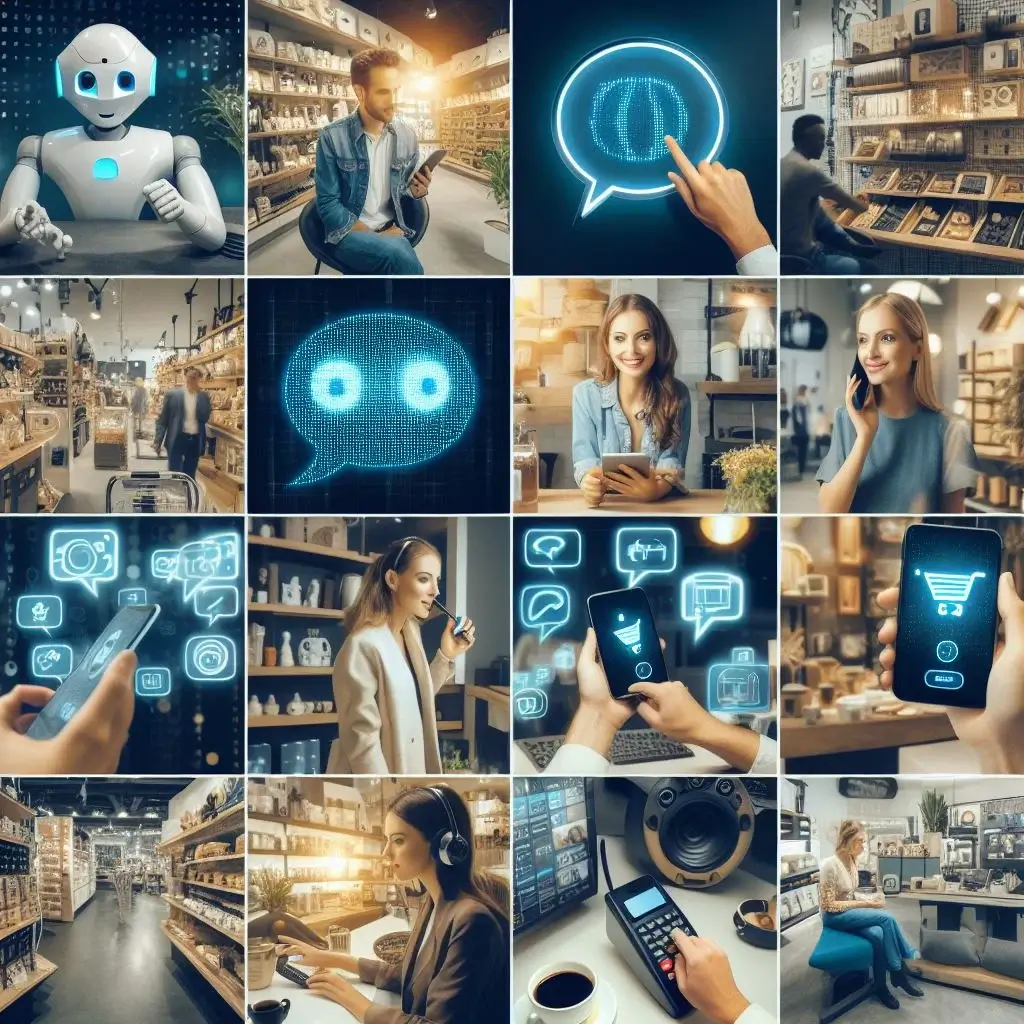When was the last time you looked to find something in a store for an hour and no one helped you? Doesn’t it bother you? Think about going into the same place and being greeted by a nice person who is ready to assist you find what you need, answer your questions, and give you ideas. Shopping habits are changing rapidly and you can say “Alexa, add that to my cart.” This is the potential of conversational AI in stores.
I’m constantly interested in how emerging technology is changing our lives because I like tech and deals. Conversational AI will change how shops work, that much I can say. It’s a new tool, though, so people worry and have questions. Prepare yourselves, because you’re about to enter the exciting arena of Conversational AI in retail. We’ll talk about where the technologies are now and how they could influence the way we shop in the future.
What Do You Mean by Conversational AI in Retail?
Think about having a personal shopping assistant you could call at any minute, day or night, on the phone, online, or even in-store at a booth. That’s pretty much what talking AI in stores offers. Stores can have realistic talks with customers in real-time by using robots, voice helpers, and other interactive tools. These AI-powered assistants can answer questions about products, make personalized suggestions, help with transactions, and even give updates on entertainment or reward programs.
Not only robots that can talk, even though. Conversational AI in retail is more than that. Machine learning can help you figure out what your customers want, gather information about them, and give them a more tailored experience. It’s similar to having a very smart friend who understands what you like, helps you pick out good things, and makes shopping more fun and easy.
Trends and Developments Conversational AI in Retail
There is a lot of growth in conversational AI in retail and things will only get easier from here on out. Here are some important changes and trends:
- Multichannel integration: AI helpers can now work on more than one site. They’re combining speech, chat, social media, and even kiosks in stores to make digital interactions smooth.
- Advanced personalization: AI is learning to make talks more personal in ways other than just suggesting products. You can get different answers based on your past purchases, your demographics, and even your feelings. This makes each shopping experience truly unique.
- As smart speakers grow, voice assistants such as Google Assistant and Amazon Echo are gaining prominence in the realm of online commerce. These assistants let customers buy things and handle their accounts without using their hands.
- Focus on ethical AI: As this technology develops, attention is moving to ethical development and responsible data use to make sure AI agents work in the best interests of their customers.
This fast change only means one thing: AI that can have conversations in stores is here to stay. But with a lot of power comes a lot of duty, and stores need to use their power honestly and carefully. Also you can use Google AI to improve your marketing for the store and can get automatic review with AI.

Wide Range of Use Cases of Conversational AI in retail
The use of conversational AI in retail goes beyond the removal of overly talkative salesmen. It’s about giving customers smooth, unique, and interesting experiences through their path. Here are some different ways this technology can be used to show how powerful it is:
1. Making it easier to Find and Choose Products:
- Personalized Product Suggestions: AI helpers look at past purchases, demographics, and viewing habits to make product suggestions that are more relevant to you. This saves you time and effort.
- Smart Search Functions: Chatbots can understand natural language questions and help people quickly and easily find specific goods or narrow down their choices.
- Visual Search: Customers can share pictures or use their cameras to find goods that are similar or that are linked to ones they already have.
2. Making Customer Service and Support Better:
- Artificial intelligence assistants are accessible at all times, day or night. This allows human agents to focus on more complex issues while these bots handle basic inquiries regarding products, sales, and store policies.
- Answering Simple Questions: Chatbots can handle returns, swaps, and questions about tracking orders, which cuts down on customer wait times and anger.
- Bringing in Human Agents: When it’s necessary, AI can easily hand off complicated problems to real people, giving them more information to help them solve the problem faster.
3. Getting More Sales and Conversions:
- Deals and Upselling: AI can offer focused deals or suggest related goods based on a customer’s likes and dislikes and past purchases.
- Recovery of Abandoned Carts: Chatbots can send unique messages and rewards to customers to get them to finish their orders.
- Dynamic Pricing and Discounts: AI can change prices based on real-time demand and groups of customers, which increases sales and results.
Read: How to Use Conch AI For Writing
4. Building Customer Loyalty and Engagement:
- Chatbots can answer questions about loyalty programs, give unique prizes, and keep track of progress, all of which make people more interested in participating.
- Personalized Welcomes and Deals: AI can tell when a customer has bought from you before and offer special deals or suggestions, which makes them more loyal.
- Follow-up after the Sale: Chatbots can offer help, ask for comments, and give product usage tips, which builds trust and good relationships.
5. In-store Customer Support and Navigation:
- Interactive Kiosks: Kiosks that are driven by AI can answer questions about products, suggest things, and even show customers how to find their way around the store.
- Voice helpers for customers who are blind or have low vision. AI agents can read aloud descriptions of goods and shop plans, making the store more accessible.
- Personalized Ads in Stores: AI can recognize customers by their phones and send them offers that are more relevant to them based on what they like.

Popular Conversational AI for Retail and How to Use Them
Here are a few of the most well-known conversational AI tools and how you can use them to help your store:
Watson Assistant from IBM: Conversational AI in Retail
Features: Powerful natural language processing, displays that can be changed, and access through web, chat, and voice.
Strengths: It’s very flexible, has strong analytics, and works with IBM Cloud services.
Retail Use Cases: suggesting products, getting help from customer service, keeping track of orders, and sending out personalized ads.
How to Use: The Watson Assistant interface lets you make personalized apps that can connect to other platforms and learn from your product data and customer chats.
Google Dialogflow
Features: It has a simple layout, pre-made themes, and works with Google Assistant.
Strengths: It works well with Google Cloud services, has a range of price choices, and understands natural language well.
Use Case: Virtual buying helpers, in-store platforms, custom product suggestions, and gathering comments are all examples of retail use cases.
How to Use: Use the Dialogflow console to plan conversation flows, use pre-made themes for common jobs, and connect to Google Assistant to talk to it.
Amazon Lex
Features: Deep connection with Amazon Web Services (AWS), support for various languages, and data built right in.
Strengths: It’s cheap, easy to set up, and works well with the AWS environment.
Use Case: Stores can use it to keep track of their orders, accept returns and swaps, make personalized product suggestions, and offer customer service in more than one language.
How to Use: Use the Lex platform to design chatbots, use themes and tools that have already been made, and connect to AWS services for data storage and insights.
Microsoft Azure Bot Service
Features: Support for all channels (web, SMS, social media), AI models that are already built, and interaction with Microsoft tools.
Strengths: It is safe and reliable, and it works with Azure AI services and has powerful programming tools.
Use Cases in Retail: Virtual shopping helpers, customer service questions, managing reward programs, and making appointments.
How to Use: The Azure Bot Service interface lets you make robots, use pre-built AI models for language translation and mood analysis, and connect to Microsoft products like Dynamics 365.
ManyChat Conversational AI in Retail
Features: You can create chatbots with a simple drag-and-drop interface, and it comes with pre-made themes.
Strengths: It’s inexpensive, and simple to use even if you don’t know how to code, and the community is very supportive.
Use Case: For tasks such as answering commonly asked inquiries, reclaiming abandoned shopping carts, creating leads, and delivering promotional offers, simple robots may be used.
How to use: Either choose an existing design or create your own using the drag-and-drop interface. Instagram, Facebook Messenger, and other well-known networks are also available for connection.
Tip for Selecting Conversational AI
When choosing a talking AI tool, think about what you need and how much you can spend. Important things to consider include professional know-how, functions that are wanted, and how well the system will work with other systems.
Also Check: 5 Best AI for Real Estate For Agents to Stay Advanced 2024

Surveys on Conversational AI in Retail Industry
| Survey Title | Conducted By | Key Findings |
|---|---|---|
| Consumer Preferences for Conversational Commerce | LivePerson 2020 | 75% of people would spend more with brands that let them message them, and 85% of people are open to messaging with brands. |
| Most Consumers Think Traditional Chatbots Are Bad at Their Jobs. Could Conversational AI Be The Solution? | Capterra 2023 | 78% of people have used a robot in the last year, but only 34% think they are useful. |
| Putting the AI in Retail: Survey Reveals Latest Trends Driving Technological Advancements in the Industry | NVIDIA 2024 | 69% of businesses who use AI say their annual sales went up, and 72% say their working costs went down. |
| Retail Chatbots: 2023 Consumer Survey | Capterra 2023 | For complicated questions, 61% of customers would rather talk to a real person than use a robot, and 71% think chatbots will be helpful and quick. |
| The State of Consumer Trends in Shopping 2024 | Sensor Tower 2024 | 50% of smartphone users in the US shop online through mobile apps, and 37% shop on social media sites. |
| Retail Customer Experience Trends Report 2024 | Zendesk 2024 | 73% of customers want unique shopping experiences, and 64% do research online before buying something in a store. |
| Global AI in Retail Market 2024-2029 | Research and Markets 2024 | The market for AI in retail is projected to hit $36.81 billion by 2029, rising at a 36.5% CAGR. |
FAQs on Conversational AI in Retail
Will AI assistants take the place of store workers?
Not really. To free up workers for more complicated exchanges and personalized service, they’ll probably automate jobs that are done over and over again.
Can I trust my AI assistant, is it safe to use?
Privacy and data protection are very important issues. Retailers should make sure their data methods are clear and their sites are safe.
Can AI understand what I want and need?
For sure, AI is getting better at picking up on subtleties, but it’s still learning. People should be skeptical when they hear suggestions.
Final Thoughts on Conversational AI in Retail
Now that you have a better understanding of this interesting trend, consider the following:
Allow AI helpers to give you knowledge and suggestions; enjoy the experience. The things you find might surprise you. Feel free to clarify replies that aren’t clear or ask for more particular information if needed. AI helpers are always picking up new things. Data privacy is important. Pick stores that are clear about how they use data, and make sure your privacy settings match.
Tell us about your experiences with AI helpers, both good and bad. Your feedback helps them get better at what they do.
Keep in Mind that conversational AI in retail is only a tool and not an alternative for talking to people. We can make a world where technology makes shopping better for everyone by being smart about how we use it and pushing for responsible growth.